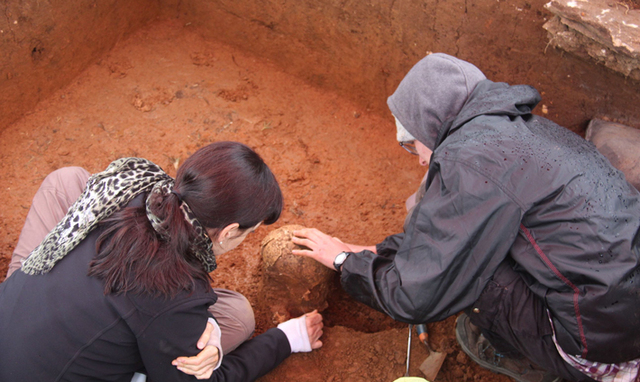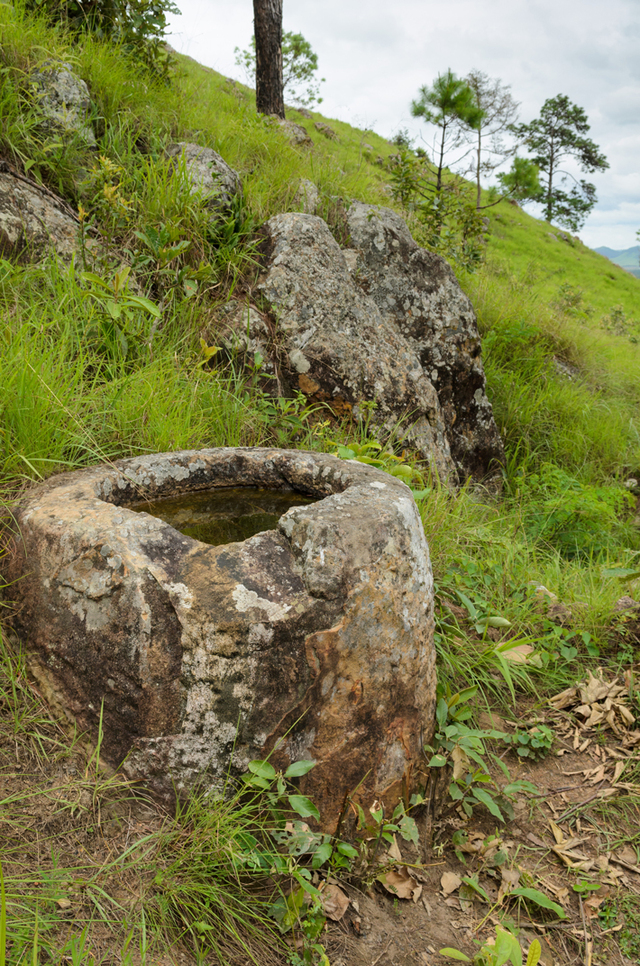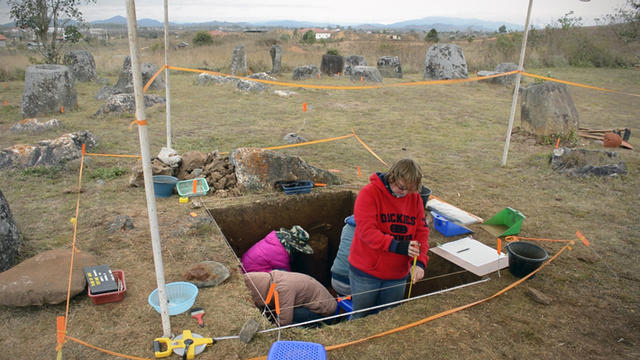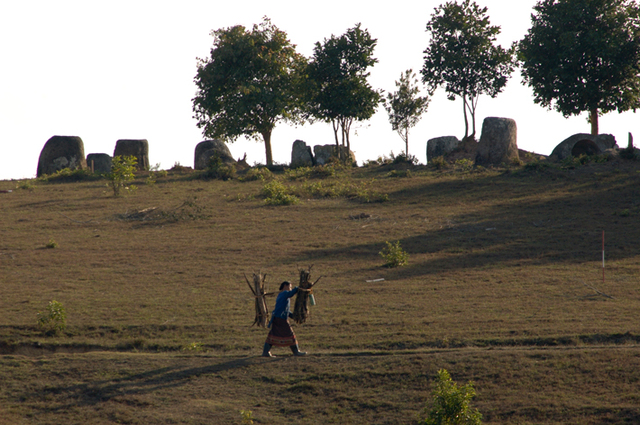The Plain of Jars in Laos holds a mystery that has baffled archaeologists for centuries. Dotted with over 2,000 massive stone jars spread across vast, remote landscapes, this UNESCO World Heritage site offers more questions than answers. Despite the limited excavation and absence of written records, new technologies are finally peeling back layers of history, offering glimpses into the ancient civilization behind these colossal artifacts. The journey to uncover the truth behind the Plain of Jars is only just beginning.
The Landscape and the Jars: An Ancient Puzzle
The Xieng Khouang Plateau in northern Laos is home to over 2,000 ancient stone jars scattered across 2,100 square miles. These massive jars, some weighing up to 25 tons, are found primarily on mountain slopes, with the largest specimens measuring up to nine feet tall and six feet in diameter. The majority of these jars are made from sandstone, with the heaviest weighing several tons. One of the most significant locations for these ancient megaliths is Site 1, which contains 344 jars in an open space outside the town of Phonsavanh, the capital of Xieng Khouang province. Despite the scale of the site, archaeologists have only uncovered a limited understanding of its creators.

The main mystery remains: who were the people who created these monumental jars, and what role did they play in ancient society? The lack of written records, domestic structures, and habitation sites has made it challenging to determine their identity and purpose. However, through a combination of excavation and modern technologies, archaeologists are beginning to unlock the secrets of this fascinating site.
Video
Watch the video to uncover the mystery of the massive stone jars left by ancient giants in Laos’ Plain of Jars. This enigmatic site has puzzled historians for centuries!
New Archaeological Technologies Illuminate the Past

One of the most exciting developments in recent research on the Plain of Jars is the use of modern archaeological technologies. The Unraveling the Mysteries of the Plain of Jars project, a five-year endeavor funded by the Australian Research Council, is combining traditional excavation techniques with advanced scientific tools. Techniques such as isotopic analysis, drone mapping, and Geographic Information Systems (GIS) have enabled archaeologists to gain deeper insights into the landscape and the people who lived there.
In 2016, the team began excavating at Site 1 under challenging conditions, including freezing temperatures and rain. Despite these challenges, the archaeologists uncovered significant findings, including a human skull, bones, and teeth, which have provided valuable information about the burial practices of the people who used the Plain of Jars as a mortuary landscape. These bones are being analyzed using isotopic techniques to understand whether the individuals buried there were local to the region or came from other areas. This research could shed light on the movement and lifestyle of these ancient people.
Site 1: Excavation and Discoveries

The first season of excavation at Site 1 in 2016 led to the discovery of multiple burial types, including primary and secondary burials, as well as inhumation jars containing bones. The finding of these different burial practices suggests a complex mortuary ritual and provides evidence of a highly organized society. One of the most intriguing discoveries was the skull of a woman, named “Burial 5,” found buried near other bones and teeth. The presence of these multiple burials within a single location offers researchers a unique opportunity to understand the social structure and customs of the people who lived in this region.
The excavation of the human remains has opened a new chapter in the study of the Plain of Jars, with scholars now able to ask questions that were previously unanswerable. Did these burial practices occur simultaneously? Did the different types of burials represent different social classes or groups within society? These questions will be addressed through further excavations and analyses of the skeletal remains, shedding light on the complexities of ancient life in Laos.
Uncovering Burial Practices and Cultural Insights

The variety of burial practices found at Site 1 offers valuable insights into the cultural and religious practices of the people who inhabited the area. Primary burials involve placing the deceased in their original burial spots, while secondary burials are more common and involve the reburial of remains. The inhumation jars, which contain the bones of the deceased, provide additional evidence of the funerary rituals practiced at the site.
One of the primary research goals is to understand whether the burial types at Site 1 were contemporaneous, and what that can tell us about the people’s beliefs and social structure. Were the individuals who created the jars local to the area, or did they come from further afield? The isotopic analysis of the remains will provide an answer to this question and may reveal that the people of the Plain of Jars were part of a larger, interconnected network in Southeast Asia during the Iron Age.
The Impact of War on the Plain of Jars
The history of the Plain of Jars has been deeply affected by the Vietnam War and the subsequent bombing campaigns that ravaged the region. Between 1964 and 1973, more than two million tons of bombs were dropped on Laos by the United States during the conflict. The region, known as Xieng Khouang, was heavily targeted as part of the battle between the communist Pathet Lao and the U.S.-backed Royal Lao Government.
The bombs dropped in the area have left a lasting impact on both the landscape and the people. Many of the jars were destroyed or displaced during the bombing, and the presence of unexploded ordnance, known as “bombies,” continues to pose a significant danger to locals and archaeologists alike. In addition to this, the remote nature of the jar sites made archaeological work extremely difficult. Today, bomb clearance efforts are still underway, and archaeologists must exercise extreme caution when excavating in the area.
Site 52: A New Frontier for Research
While much of the research to date has focused on Site 1, Site 52, located about 20 miles away, is expected to yield new insights into the Plain of Jars. Excavation at Site 52 has not yet begun, but previous surveys have shown the site to be one of the most significant on the plateau. With its four known jar groups and numerous stone discs, Site 52 promises to provide more answers to the ongoing questions about the burial practices and culture of the people who created the jars.
The excavation of Site 52 will focus on identifying skeletal material for DNA comparisons and isotopic analysis, which will further our understanding of the connections between the people of the Plain of Jars and the larger ancient world. Researchers will also be looking for evidence of trade, as the stone jars may have been used to store precious items such as tools, beads, or ceramics.
Future Research: Unsolved Mysteries and Continued Exploration

The ongoing research into the Plain of Jars is providing new opportunities for archaeologists to explore one of the most mysterious sites in Southeast Asia. With the aid of new technologies, scholars are gaining unprecedented access to the ancient mortuary landscape. The use of drones, GIS mapping, and advanced isotopic analysis is allowing researchers to piece together the history of the people who created the jars and their burial practices.
Despite all the new discoveries, many questions remain. What was the role of the jars in the society that created them? Why were they placed in such a specific and strategic manner across the landscape? And how did these ancient people transport such massive stones over difficult terrain? These are just a few of the questions that future research will aim to answer.
Video
Check out the video to learn about the mysterious Plain of Jars in Laos, now a UNESCO World Heritage site. This ancient wonder continues to spark intrigue and curiosity!
Conclusion: A Land of Ancient Rituals and Modern Challenges
The Plain of Jars continues to be one of the most fascinating and enigmatic archaeological sites in the world. As new technologies enable researchers to uncover the secrets of the site, our understanding of the people who created the jars grows. The complex burial practices, the mystery of the jars’ creation and transportation, and the impact of war on the region all contribute to the significance of this site. As ongoing research continues, the Plain of Jars will remain a testament to the rich cultural history of Laos and the resilience of its people.



